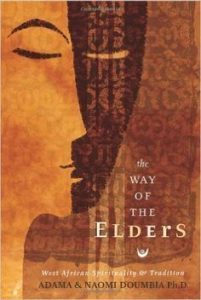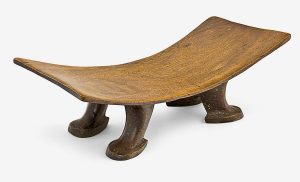A few days ago, my friend in Germany sent me the video, titled Ashanti Traditional Buildings, which shows the shrine of Tano, the river deity of the Akan people, and the Okomfo, one term for “shaman” among the Akan and Guan peoples. This video is of a shrine among the Ashanti, one of the main groups of the Akan people. It stimulated me to put together this article, which I had been meaning to write for a while now. Let’s have a look at this video:
Before going into the subject some more, allow me to just mention that Akan traditional spiritual practices, and in fact the traditional spiritual practices of others in Ghana, and elsewhere in Africa and beyond (e.g. the Chinese, Japanese and Vietnamese) have an understanding of and a reverence for ancestral spirits. The same can be said for some of the indigenous people in North America, and in aboriginal Australia, who understood the role ancestors play in the continuity of culture and existence. If we push things further, you would even find spiritual practices to commune with ancestors in India, in Roman times (where families had shrines for ancestors), and also in Ancient Egypt and Nubia. Suffice to say, venerating and communing with the ancestors is a very old and well-established spiritual practice among the peoples of this planet.
And now to delve into practices specific to the Akan and Guan peoples. In this article, I shall draw in particular on work by Okomfo Ama Boakyewaa, whose Ph.D. thesis, titled Nana Oparebea and the Akonnedi Shrine: Cultural, Religious and Global Agents, explains to us among other things aspects of Akan cosmology, as well as the process is to become a priest or a priestess. Among the Akan and Guan peoples of Ghana, the title Okomfo denotes an individual who has undergone training as a traditional priest or priestess over a protracted period of time, and who has passed the initiation process to become a traditional priest or priestess. So, let’s get right into it.
Spirits within Akan and Guan traditional thought
Making reference to Kofi Asare-Opoku’s book West African Traditional Religion, Okomfo Ama Boakyewaa explains the Akan deities to us as falling into three categories – state deities, family or household shrines, and deities/spirits that are parts of talismans:
“The deities (abosom) are associated with rivers, lakes, streams, seas, oceans, lagoons, lightning, trees, herbs, wind, and all other natural elements. They fall into three main groups: (1) tutelary deities, tete abosom or abanafo, which help cleanse the state, e.g., Tano (river), Mframa (wind), or Bosomtre (lake) are all state deities, (2) family or household shrines, which are dedicated to each lineage but also have widespread efficacy to all who seek their help, e.g. Asuo Gyebi, Sankᴐfa, Gyeabour, and Asuo Abena and (3) suman, bosom brafo, or suman brafo. These latter can be owned or purchased by individuals and are embodied in physical objects that can be stationary or portable in the form of talismans (care needs to be taken with these since their energy can manifest in negative or positive ways depending on the intent of the owner).” (p. 34)
She explains that deities can be called upon to aid people in both positive and negative pursuits, and to these ends, she explains with examples of hos this can happen. Okomfo Ama Boakyewaa also tells us about the ancestors, how the Akan relate to them, and what the procedures are:
“An Akan proverb says, Onipa wu a na onwui (When a man dies, he is not really dead). Nsamanfo, ancestors, or the “living dead” are the spirits of the departed, who remain a part of the family and must be taken care of at certain specific times, such as Adae (the special days that occur at forty-day intervals throughout the calendar year), and fall on Sunday (Kwasiadae) or Wednesday (Wukuadae). At these times, libation is poured to honor the ancestors, and they are fed sacred food in the form of mashed yams and palm oil known as εtᴐ. Evolved and positive ancestors who have “achieved their hyεbea (life’s mission) …and ‘crossed’ the waters’ to the asamando (place of the ancestors),” have not died in suspicious circumstances like homicide, accidents, or suicide. They have lived long, exemplary lives and positively influenced the family and community. The other kind of death that is acceptable for evolved ancestry is death in war. Ancestors are most concerned with the morals, reproductive and productive success of their family line. To anger or violate the ancestors’ wishes is ill-advised, since that could endanger the life and limb of the individual transgressor, as well as the group through spiritual diseases (discussed earlier in this chapter). Also, if a person is an evolved ancestor and is neglected, there will be even more problems for the family that could lead to spiritual diseases, failed crops, marriage problems, and even children or adults dying. Keeping the good spirit requires that the proper rites be done at death, burial and all of the subsequent observances for the celebration of the forty-day, eighty-day, and one-year commemoration of the death.” (pp. 35 – 36).
So here we learn even more about the Akan view of ancestors. I would like to add that there are rites to be done for ancestors even after the forty-day, eighty-day and one-year commemoration ceremonies. It also depends on the type of ancestor. For instance, if the ancestor was a traditional leader, there may be more ceremonies needed. Now, let us read a bit about what Okomfo Ama wrote on the dwarfs:
“The dwarfs or mmoetia are the “mysterious little people’ as coined by former California State University professor, Gabriel Bannerman Richter. He has done extensive research on the dwarfs and written Mmoetia: The Mysterious Little People based on his empirical evidence. Dwarfs reside in the deep forests and are known to kidnap humans and take them to the heart of the forest to train them as priests in herbal healing. They can, “be an asset or a distraction,” and according to several of my respondents, they can be very demanding. They are very short creatures who have their feet situated with the toes pointing backwards. Their voices are very high-pitched similar to a whistle or a screech. The dwarfs have dreadlocks and wear a raffia skirt (doso) decorated with cowrie shells, bells, and talismans filled with medicine. Their faces have white powder or clay across the eyes to resemble a mask. They are known to generate money and prosperity for their priests and clients, but they also require a lot of attention in terms of the foods they prefer and taboos they inflict on their priest.”
I must say that these dwarfs are fascinating beings. Many cultures have accounts of dwarfs and certainly the Akan do as well. When I was a young boy growing up in Ghana, my grandmother described the appearance and behaviors of dwarfs to me. It is the same as has been described in the passage above, especially the part about their toes pointing backwards. She used to tell me how they would occasionally appear to farmers and people in the forests, and how they can also play tricks on people and such. I too read Gabriel Bannerman Richter’s trilogy many years ago, and enjoyed them greatly. Mmoetia: The Mysterious Little People, is the third book in the trilogy. Among other things in this book, the author interviews some dwarfs, who were not keen to be video recorded. They were fine with audio recording.
I am going to share with you two videos from the Asumasem (Twi for dark/occult affairs), where two medicine men are filmed speaking with the spirits. In both videos, the traditional priests speaks in Twi (a dialect of the Akan language), and briefly in Ewe in the second video. I think these two videos a rare view into the world of spirits and the spiritual practices of Africans.If you don’t speak or understand Twi (or Ewe for that matter), you can fast forward the first video to 14:30 to only hear the part where the priest calls the spirit entity, and the second video to about 5:00. Have a look at the videos and decide for yourself.
…and the second video…
In any case, just as Okomfo Ama Boakyewaa said, you will hear the voices of the dwarfs as a very high-pitched sound, similar to a whistle or a screech. This is because these beings are multidimensional entities. They are not human beings. They come from another dimension within physical-etheric reality. In order to hear their words clearly, as opposed to the screeching/whistling sound, an individual must take some oaths, and then undergo some herbal medicine application. In ancient times, these beings were abused by people, so now they have strict rules for getting to interact with them.
Finally, Okomfo Ama Boakyewaa also shared some more about the negative side of spirituality:
“The predominantly negative forces of the Akan universal scheme are samanbↄne (negative ancestors), sumanbↄne (harmful talismans or objects), and lastly sasabonsam (the forest monster or more commonly known as the “devil”). That witches are real is accepted in the Akan worldview in political, educated and affluent circles as well as the general population.” (p. 37)
I would comment that if you read the first two books in Gabriel Bannerman Richter’s trilogy, in the first book you’ll get to read about traditional knowledge regarding witches, the different kinds of witches and how the negative ones can be “arrested”, and in the second book you’ll get to read an autobiography of a witch. Now, let’s move on to discuss how to become an Okomfo (i.e. an Akan-Guan “shaman”) by undergoing the Akom initiation. Before that, let’s examine some terminology. First, Akom (or more properly, Akↄm – “o” and “ↄ” are very close sounds), is the term used by Akans and other Africans in the diaspora knowledgeable of or trained in traditional Akan priesthood to denote the ritual ceremony of drumming, dancing and singing, during which the Okomfo (i.e. priest (shaman)/priestess (shamaness)) often becomes possessed with the deity or spirit (s)he serves, and during which the spirit can interact with members of society at the ceremony. The spirit could be a family deity or an ancestor. The term is also used to denote the process through which the initiate (and the qualified practitioner) engages with spirit and with society. So properly, it is a way of life. Next, the process of receiving prophesy is termed “nkↄm”. Akomfo/Okomfo is the person that practices Akom. Akomfa is the call from the deity (more on that in the section below), akommu is the training period, and akomyi is the graduation. With that, let us proceed to the next section.
How people become traditional priests among the Akan and Guan peoples
While many candidates for traditional priesthood are selected by the spirits themselves (who could be spirit deities, dwarfs/mmoetia, or ancestors), others are also accepted through other means. For the first kind, the spirt selects them through spirit possession. These possessed people can sometimes appear “crazy”. Once they are taken to a shrine, they can receive help, and then begin training to become priests or priestesses. For the second kind, a child can be given to a shrine after a woman that was previously infertile gives birth with help from the shrine, or a family member can be given to a shrine to break a curse. are given to shrines either because a woman had a child. According to Okomfo Ama Boakyewaa, training during initiation takes at least 3 years, 3 months, 3 weeks, and 3 days.



